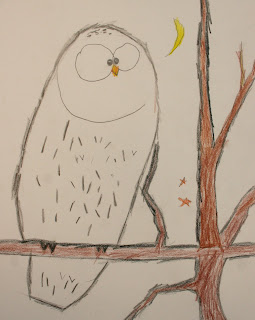We lived in Boyertown, PA for 7 years, and we saw plenty of hex signs on barns everyday. There are more towards Kutztown and surrounding rural areas. Hex signs are only found in this area of PA and are a tradition of the Pennsylvania Dutch (not the Amish). We usually start the lesson with examples of hex signs, mostly from things I have collected from the annual Kutztown Festival. We use a ruler and compass to help the design to be symmetrical. I print out the other elements that are used in Hez sign designs and their meanings: diselfink, rosette, scallop, star, oak leaf, tulip, heart, pentagram. This is usually the first time artists have used a compass in art, so I give them plenty of practice paper to make circles. We use stiff bristol for the finished work. Hex signs are very colorful, so we use colored pencil or crayon, and paint will work great.
Showing posts with label colored pencil. Show all posts
Showing posts with label colored pencil. Show all posts
Rolling Landscapes
I don't tell the students what we are drawing when I give them the directions for this artwork: Hold your paper portrait and make 7 wavy lines, letting your natural top-to-bottom hand motion create the rolling hills. Turn your paper landscape and draw 3 mountains. Add 5 trees (no lollipop trees), 3 patchwork fields, 1 barn, 3 animals, and 1 fence. (barn, trees, and animals must be smaller than mountains)
I often let the students do anything else extra creative as long as their drawings have the few required items. These suggestions help younger students be creative and help them to fill the page. We finish with marker outlines and colored pencil.
Hand Drawings
This very talented student loves to draw from life, especially Littlest Pet Shop toys. His favorite color is red. He wants to draw a black panther during next class.
Owl Drawings
Owl Drawings

This owl drawing begins with color photos of real owls as research and inspiration. I often encourage the combining of elements from two different photos for individual drawings. For example, the branches of one photo and the owl of another photo. Start by drawing branches for for the owl to perch, one in foreground, one in background. By drawing the owl lightly with pencil, make sure that the tail is 1/3 or 1/4 the length of the owl itself, and the tail hangs down below the branch it is sitting on. Discuss symmetrical eyes and talons. I use this as a chance to work on drawing branches, suggesting thick to thin lines, long and short lines. Finish by layering colored pencil.

Subscribe to:
Posts (Atom)






_new.JPG)

